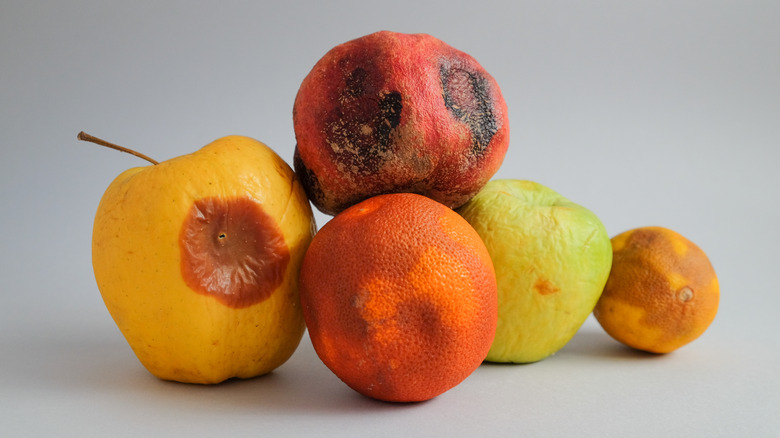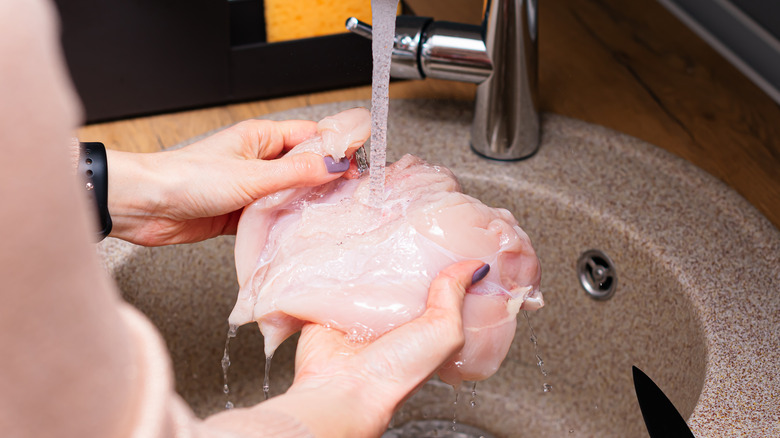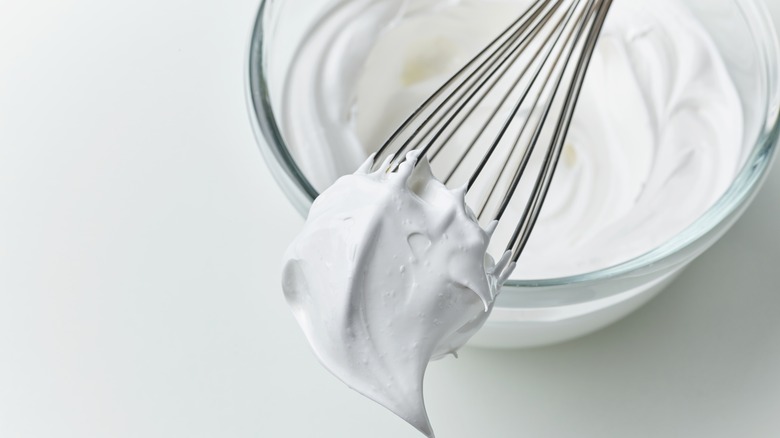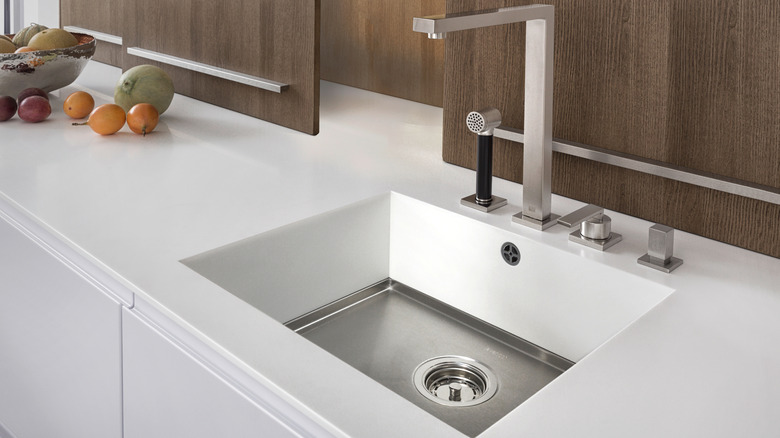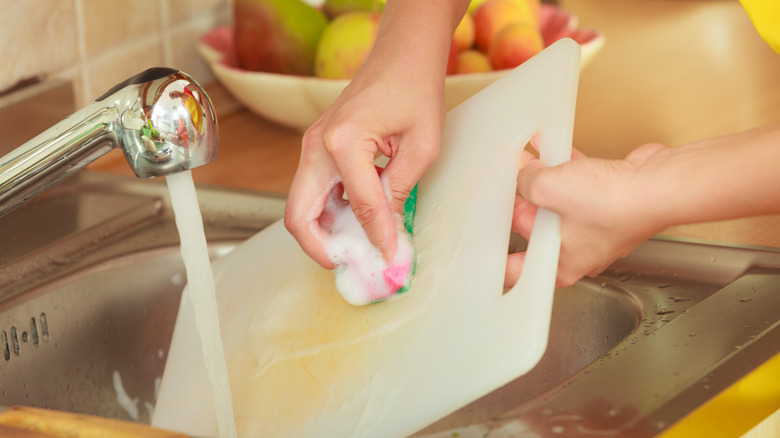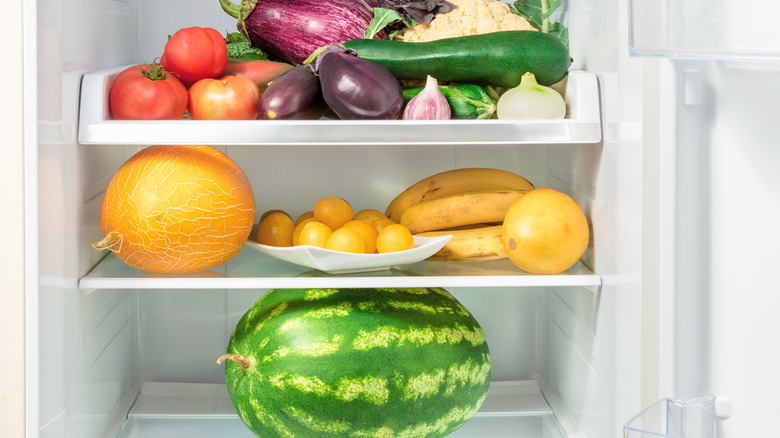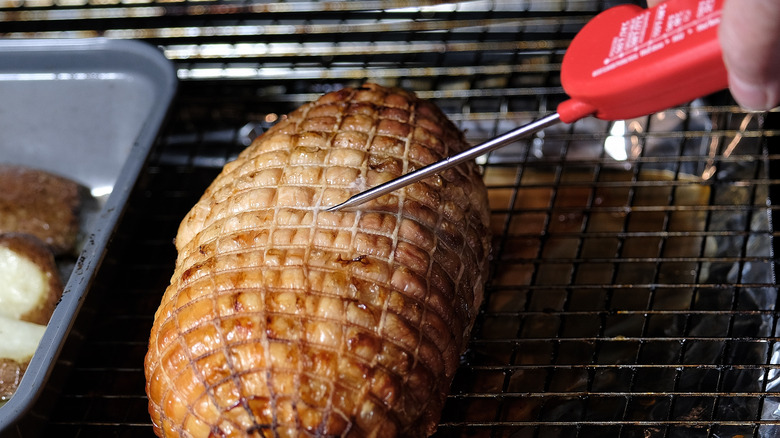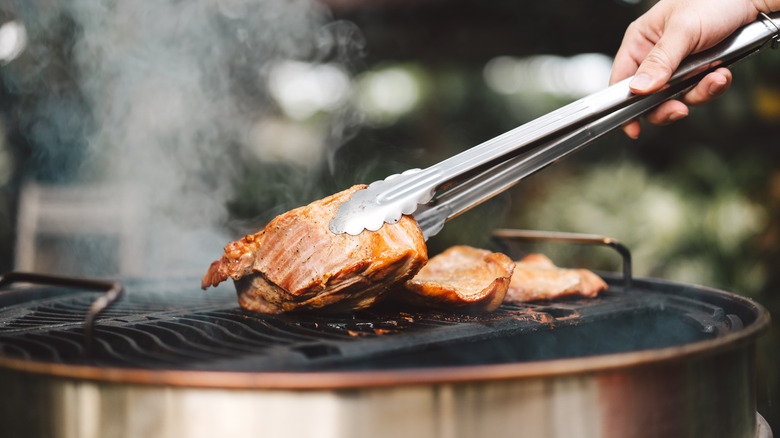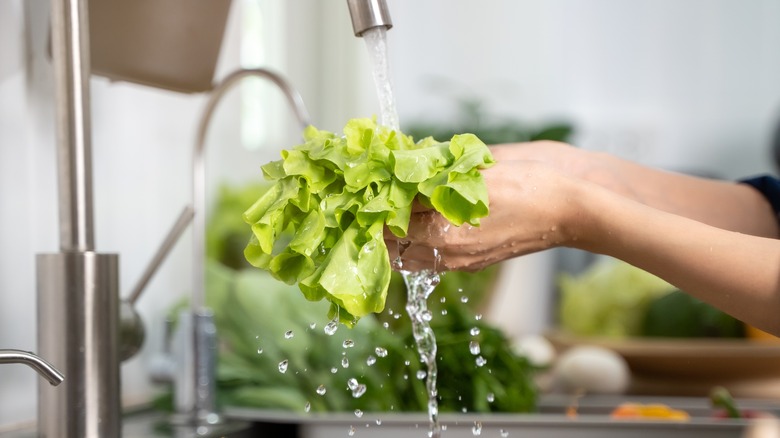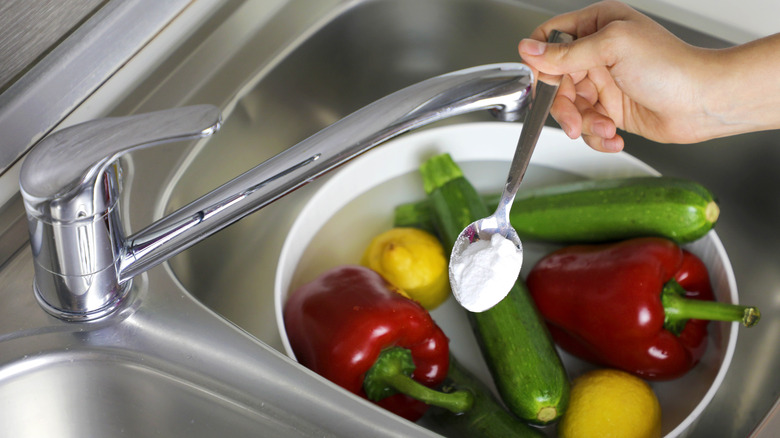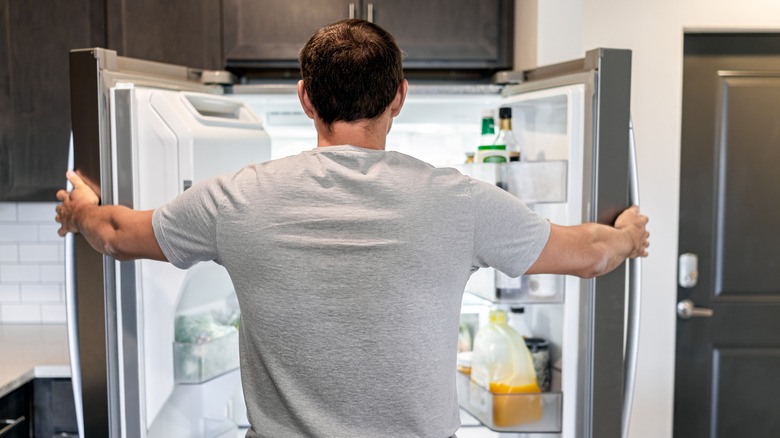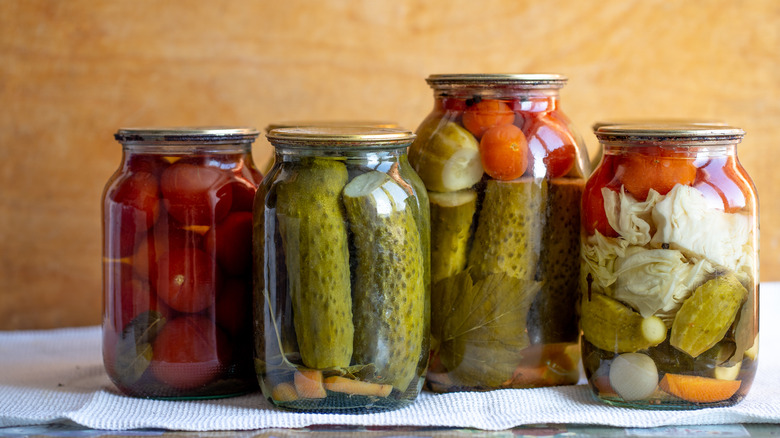14 Food Safety Tips Every Home Cook Needs To Know
The Minnesota Department of Health defines a "foodborne illness" as sickness resulting from contact with bacteria, viruses, or pathogens in food. Common signs include cramping, nausea, fever, and lethargy, but specific symptoms are often dependent on the type of pathogen. The most well-known types of these sicknesses include E. coli, giardia, salmonella, and Campylobacter. According to the Centers for Disease Control and Prevention (CDC), nearly 48 million Americans are sickened by these and other illnesses annually, resulting in over 128,000 hospitalizations and 3,000 deaths.
Foodborne illness is usually a topic that makes folks a bit squeamish. It's hard to think about the pathogenic dangers that lurk in a home kitchen — and it's even more daunting to think that it's often hard to recognize a food that has been tainted. Although it is obvious that some pathogens are integrated into the food system, there are ways that home cooks can reduce their risk of contracting one. Here are some of the most important things you need to know about foodborne illnesses to keep you, your family, and your kitchen safe.
Washing your chicken before cooking may spread salmonella
Some recipes may advise you to wash your chicken before cooking. If you're someone who does — stop.
According to the CDC, 1 million Americans become sick from eating contaminated poultry every year, making it one of the most frequent causes of foodborne illness. In fact, one in every 25 packs of chicken at the average grocery store is contaminated with salmonella, a bacteria that infects the human intestine. When chicken is washed under water, the juices splash onto counters, glasses, and surfaces that humans interact with regularly. Other ingredients might also encounter the chicken fluids and mobilize the bacteria in your kitchen.
Instead of washing your chicken in the sink, pat the meat dry with paper towels to remove excess liquid. Be sure to wash your hands before and after handling raw chicken to prevent the spread of foodborne illness, and wipe down common surfaces like cabinet knobs and refrigerator doors to further stop the spread.
Raw animal products are common sources of foodborne illness
Raw or undercooked meats and animal products are some of the most common vectors of foodborne illnesses. These can include everything from unpasteurized (raw) milk and cider, raw shellfish, raw eggs, or undercooked poultry and red meat.
Dairy products are made safe for consumption via pasteurization; raw products are significantly more dangerous for consumption because they omit the pasteurization step. According to the CDC, raw milk and pasteurized milk have the same nutritional benefits, so always purchase pasteurized dairy, pasteurized raw cheeses, and pasteurized frozen dairy products.
Eggs are another potential vector for salmonella. There is no way to detect if an egg has been contaminated by the naked eye, so it is always best to assume that all eggs are potentially contaminated. Eggs need to be stored below 40 degrees and cooked thoroughly until the yolks and whites are firm. The CDC also advises consumers to avoid eating raw egg products including cookie dough batter, eggnog, and homemade Caesar salad dressing.
Be wary of cross-contamination on common kitchen surfaces
Avoiding cross-contamination in the kitchen is one easy way to prevent transferring foodborne illnesses. The United States Department of Health and Human Services recommends having one cutting board in your kitchen for slicing raw produce and ready-to-eat food (such as cheese for a salad) and another cutting board for raw meat, poultry, and seafood. You should thoroughly wash all cutting boards and utensils with warm, soapy water after use.
Although one of the most common transfer points of foodborne illnesses is during the preparation process, failure to properly store raw foods, meats, and animal products is also a potential mechanism for cross-contamination. The best way to store eggs is in their original carton in the main compartment of your refrigerator rather than on the door. Not only is the door subject to temperature fluctuations that cause bacteria to thrive, but it is also a dangerous place for dropping and cracking. Raw and cooked meat should not be stored together, either; the leakage from raw meat can easily infect other foods. Store all raw food in a sealed container at the bottom of your refrigerator.
Replace plastic cutting boards annually
Although wooden cutting boards are aesthetically pleasing, they can potentially harbor more foodborne pathogens than plastic cutting boards. Wooden boards can be more susceptible to bacteria as wood is porous and holds juices easily, but antimicrobial properties in wood could help slow bacterial growth, per Hell's Kitchen Recipes. Plastic cutting boards are also dishwasher-safe and lightweight for easy kitchen mobility.
There does come a time when plastic cutting boards need to be replaced, though. Those that are worn out can harbor bacteria in the grooves, despite a cook's best efforts to clean them. Plastic ones should be replaced at least once a year while wooden boards should be replaced when the board appears warped or worn past the point of repair. According to CuttingBoard.com, regularly oiling a wooden cutting board with mineral oil will slow the process of liquid seeping into the wood, which in turn can delay the growth of germs and bacteria.
Melons should be left at room temperature for a maximum of two hours
Although the fruit may look unassuming, melons are actually one of the most dangerous produce items associated with foodborne illnesses. Cantaloupes (musk melons) are the most common culprit, but there are some instances of watermelon and honeydew outbreaks, per Food Safety News. Cantaloupes are primed for outbreaks; they have a bumpy rind that harbors pathogens in its nooks and the fruit grows on the ground where rodents and pests can infect it. After the skin is penetrated (either by cutting or by accident), the bacteria seep into the warm, wet conditions inside of the melon and flourish.
Whole melons should be left at room temperature on the counter while sliced melons should be refrigerated immediately. To optimize food safety when working with melons, always brush the outside of the melon under warm water. Use clean utensils and always be sure to wash your hands before and after slicing. You can place melon pieces in plastic wrap, an air-tight plastic bag, or a plastic container with a paper towel to absorb moisture. The safe temperature for melons is less than 41 degrees.
There are different internal cooking temperatures for different types of meats
According to the Minnesota Department of Health, there are three important temperatures all home cooks should know. All poultry should be cooked to 165 degrees, all eggs and ground meat to 160 degrees, and fresh meat, fish, chops, and roasts to 145 degrees. The United States Department of Health and Human Services notes that red meat roasts and chops require at least a three-minute rest period to ensure that the innermost meats and juices are cooked.
To take a proper internal temperature, be sure to insert the meat thermometer at the thickest portion of the meat, without hitting bone or gristle. The thermometer will need to sit about half an inch into the meat to ensure that it is in the middle. After getting a temperature reading, clean the thermometer well with warm soapy water before probing the meat again to prevent the transfer of foodborne illness from raw to cooked meat.
Wash all kitchen surfaces with warm, soapy water and disposable towels
Wiping down a kitchen surface with a wet paper towel won't stop food-borne illness from spreading — in fact, it might even spread the pathogen even more! The United States Department of Agriculture notes there are two steps in properly cleaning kitchen surfaces: cleaning first and sanitizing second. First, wipe down all kitchen surfaces with a single-use towel with warm, soapy water. If you use dish towels, frequently wash them on the "sanitize" setting on your washing machine to kill leftover pathogens.
It's unlikely that cleaning will kill all of the bacteria; some bacteria like salmonella can last up to 32 hours on surfaces. The next step, sanitizing, will remove any pesky pathogens for good. Use 1 tablespoon of bleach per gallon of water or use a conventional cleaning wipe to clean all surfaces, making sure to dry the surfaces afterward. If you do not use a dishwasher for sanitizing, you can use your sanitizing solution on cutting boards and kitchen utensils. Be sure to rinse and dry all utensils after sanitizing.
Use separate utensils for raw versus cooked food
Cross-contamination is a danger in any kitchen, so it is important to minimize its risk as much as possible. If possible, designate one utensil color for raw food and another for cooked food. You'll want to have at least two plates for grilling, two tongs, and possibly multiple knives. If you only have one utensil (such as a meat thermometer), make sure to clean and sanitize it in between working with raw and cooked food.
If you have to use the same utensil for both raw and cooked food, it is best to prepare cooked food first before preparing raw food. This dramatically lowers the risk of pathogens being transferred onto ready-to-eat food from raw food, according to the Centre for Food Safety. This also applies to containers used to marinate raw meat; avoid cross-contaminating raw marinade with cooked meats. Always prepare a separate marinade for cooked foods.
Wash raw produce thoroughly before use
It can be hard to refrain from tasting the fresh bag of grapes you bought from the supermarket straight from the bag. But experts agree that you should wash produce before eating it for many reasons. You'll want to remove any wax, pesticides, or germs from other consumers touching the produce. The United States Department of Health and Human Services recommends washing produce under running water without using commercial cleaning products or bleach. Instead of using harsh cleaners, use a scrub brush to gently clean the outside of fruits and veggies.
Food labeled as "pre-washed" does not need to be rinsed again. Regulating agencies place stringent standards on pre-washed produce, so you can assume that these products are very safe to consume straight from the bag, according to Eating Well. In fact, cleaning pre-washed produce again can expose foods to more pathogens if your kitchen is improperly cleaned.
Produce cleaning chemicals do not actually prevent foodborne illness
There has been rigorous testing done to see if produce washes actually decrease the risk of foodborne illness. Researchers at the University of Maine found that distilled water was just as effective in removing mold and bacteria as three of the commercial produce washes tested. Moreover, the Food and Drug Administration has minimal endorsement of these products because their residue has not effectively been tested.
If you're looking for peace of mind in using something other than water, try making your own produce wash at home using distilled water, lemon juice, and vinegar. According to Good Housekeeping, adding salt to the mix may enhance the vinegar's ability to kill bacteria. You can transfer this solution to a spray bottle and spray it on the nooks and crannies of leafy greens, berries, and apples. After applying, rinse with water thoroughly to remove any flavors and residue on the produce.
Seafood requires specific sourcing and cooking to prevent foodborne illness
According to Clemson University Extension, seafood carries similar food safety risks as meat and poultry. Consumers who eat ceviche, sashimi, gravlax, or cold-smoked fish should opt for frozen products because the raw fish is kept at temperatures low enough to kill many common pathogens. Avoid packages with ice crystals or freezer damage; this could indicate the fish was thawed and refrozen.
If you plan on purchasing fresh fish, the Food and Drug Administration recommends using your nose to detect a bad catch. Fish should smell fresh; any off smell is a potential sign of contamination. The color should also be bright and consistent throughout the flesh of the fish. Norovirus is a foodborne illness transmitted through raw or insufficiently steamed clams and oysters. At home, cook oysters and clams in small pots for four to nine minutes and avoid overcrowding. Discard any shellfish that do not open. Filter-feeding shellfish like oysters are also at a higher risk of contact with vibrio vulnificus, a warm-water bacterium. Cooking oysters properly (via baking or steaming) will kill this bacteria. Certain individuals with pre-existing conditions should avoid eating raw oysters, as directed by a health professional.
Your refrigerator should be kept below 40 degrees at all times
According to the Food and Drug Administration, you should keep your refrigerator at 40 degrees or below to reduce the risk of foodborne illness. The agency also recommends keeping your freezer below 0 degrees.
So what happens if you lose power or forget to shut your refrigerator or freezer door? According to the FDA, a freezer will keep its temperature for up to 48 hours as long as it is shut. An unopened refrigerator will maintain its temperature for up to four hours without opening. While a refrigerator or freezer thermometer is important for monitoring the food's ambient temperature after this threshold has passed, you should use your best judgment to detect if your food remains safe. The appearance or color of the food cannot indicate safety, but if the package contains ice crystals or is at 40 degrees or below, the FDA notes that the food is safe to consume.
You should never thaw food at room temperature
Among the biggest mistakes people make when defrosting food is doing so at room temperature. Thawing food in a refrigerator at below 40 degrees is the safest option, per the Windsor-Essex County Health Unit. At this rate, the temperature will thaw at around five hours per pound. Alternatively, you can run the food under cold water in a sealed plastic bag to prevent the food from contaminating the sink. It is important to use cold running water to thaw the meat because warm or hot water may cause uneven thawing or safety concerns.
To avoid cross-contamination on other kitchen surfaces, you should be careful not to splash the water on other surfaces. After the food is thawed, you should remove the plastic bag quickly and sanitize all products used in the thawing process. You can microwave frozen food to quickly bring it up to cooking temperature. However, you need to make sure that you cook the food immediately after bringing the food up to temperature. This method is also not recommended for large frozen food items like a whole turkey. Cooking from frozen is also not recommended for large items — cooking burgers from frozen is very different from roasting a whole 15-pound turkey.
Following the standard for pressure canning can reduce the risk of botulism
According to information from the Centers for Disease Control and Prevention, home canning is a common vector for botulism. Low-acid foods like asparagus, corn, and potatoes are some of the most likely culprits for botulism, especially when canning is done incorrectly. Boiling water canning does not reduce the risk of botulism in low-acid foods, so you should instead stick to pressure canning.
When you start pressure canning, you should first examine the specifics of your appliance. Some county extension offices will offer recalibration of the pressure gauge to ensure that everything is accurate before you start canning. Moreover, you should be sure to clean lid gaskets and vent the pressure canner before beginning.
Just like anything else in your pantry, it's better to be safe than sorry with canned goods. If the can is bulging, leaking, or broken, you should discard the food to prevent coming into contact with dangerous bacteria that can make you sick. Any foam or liquid spurting from the can is another sign that the pressure canning was not performed correctly.
